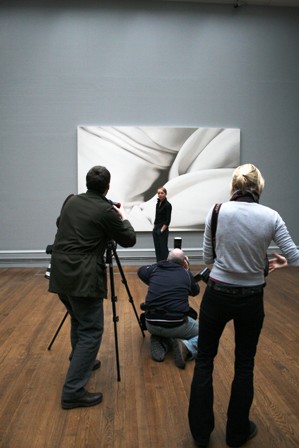Alison Watt: the National Gallery's associate artist
National Gallery director Nicholas Penny and Alison Watt
Phantom: the artist in residence
Alison Watt has marked the end of her time as the National Gallery’s associate artist with an exhibition of the work the National Gallery collection has inspired. Jonathan Ives reports
Alison Watt: the National Gallery's associate artist
National Gallery director Nicholas Penny and Alison Watt
The National Gallery associate artist scheme is perhaps the ultimate ‘artist in residence’ opportunity. Supported by the Rootstein Hopkins Foundation, the scheme enables a leading contemporary artist to work with the National Gallery collection; studio space is provided on site and the artist has full access to the collection. Alison Watt, the seventh National Gallery associate artist, took full advantage of this ‘open all hours’ opportunity during her two year residency, spending countless hours wandering the galleries when the crowds had gone home. It was an experience that inspired her work but also had a profound effect on her as an artist and a viewer of art.
Phantom, the exhibition of the work Watt produced while at the National Gallery, comprises six large-scale canvases and one smaller study, Eye, alongside Saint Francis in Meditation by Francisco de Zurbaran. This study of Saint Francis kneeling in prayer, was one of the works that had a significant influence on the artist during her stay. At first glance it is a striking contrast to Watt’s huge canvases but fabric holds the key to the connection. Alison Watt was already established as a celebrated painter of drapery when she became the National Gallery’s associate artist, with Still, her work now permanently installed in Old Saint Paul’s Church in Edinburgh, hailed as a modern masterpiece. Although of a markedly different style, Saint Francis resonates through with the new work through the folds of cloth round the head and body, the mouth open among the shadows of the habit. The de Zurbaran painting became, Watt admits, something of an obsession.
Opening the exhibition, National Gallery director Nicholas Penny confessed that it was the first time he had seen Watt’s new work and that he was still rather overwhelmed by it. He noted that artists working with the collection “do not always get it right” but stressed that clearly Watt had. “The National Gallery was founded with the idea of the benefit it could give to contemporary artists and the vitality that contemporary artists could bring to it,” he said. “The idea of bringing artists to work with the collection has never been better.”
Invited to say something of her own relationship with the National Gallery collection, Alison Watt looked somewhat overwhelmed herself.
“The last two years has been the strangest time,” she said. “It is an extraordinary opportunity and the gallery has been addictive. I’ve been here seven days a week. It is a unique experience and I wanted to squeeze every last drop out of it. I feel drained but exhausted in a good way. It is rare that you do something during your life and you know at the time that you are in the middle of an extraordinary experience. I certainly felt that.
“I thought I knew the collection quite well and I thought that I would get to understand the paintings better during my time here. In fact the effect has been quite the opposite. The collection now feels more mysterious. It feels as though I have just scratched the surface. Looking at great paintings is very demanding and I realised that I don’t know anything. You use a kind of shorthand when looking at paintings but with so long to look at them this process sort of broke down. I found myself returning to paintings that I didn’t understand, a bit like a love affair.
“I found myself looking at Saint Francis in Meditation time and time again. This was partly to do with seeing people cross the room to be with the painting. There’s a strong spirituality about the piece that attracts people and it’s as much about what you can’t see as what you can. I’ve become obsessed with the picture and particularly one part of it: the open mouth. It would be a very different picture if the mouth was closed. In my own work areas of darkness began to creep in and I’ve become fascinated by these apertures.”
Huge in scale and unlike anything else on display in the National Gallery, Alison Watt’s work will prove just as engaging. The abstract qualities of the paintings in the Phantom exhibition provide a warm contrast to the overwhelmingly figurative works that compose the National Gallery collection, drawing the observer in from draped folds into something darker and more obscure. Her experiences alone in the gallery may also require a reassessment of how we understand the paintings we love.
Phantom is in the Sunley Room of the National Gallery until 22 June 2008. Details of the National Gallery associate artist scheme can be found in the education section of the National Gallery website.
The Leisure Review, April 2008
© Copyright of all material on this site is retained by The Leisure Review or the individual contributors where stated. Contact The Leisure Review for details.
